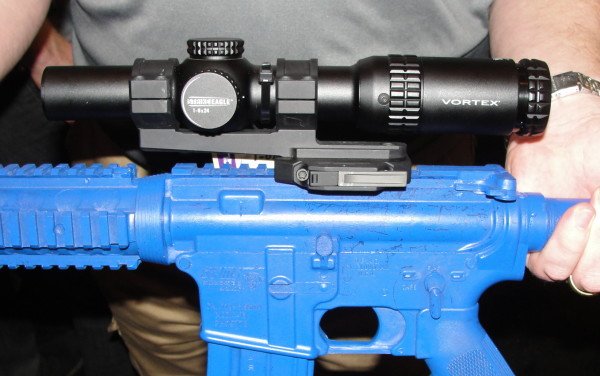
Vortex Optics is not new to the optic business by any means, and the company continues to etch their way into a larger share of the market by making some really outstanding glass. This year at SHOT Show, Vortex revealed their new Strike Eagle 1-6x24mm reflex and magnification scope. Though targeted for the AR-15 market, the Strike Eagle has a wide open range of possibilities from bolt-action to lever rifles as well.
In fact, a 1-6x magnification scope was probably the most popular product to enter the AR-15 market at this year’s SHOT Show. It seemed that nearly every major player in the optics world was coming out with their own version of a 1-6x scope, and the Vortex Strike Eagle made a strong offering.
Features of the Vortex Strike Eagle
When developing the Strike Eagle, Vortex sought to combine the benefits of a 6x scope, with the speed of a reflex sight. They also realized that to be competitive in the market the optic had to have certain features, yet still be in a price range that most shooters could afford. I think Vortex succeeded in their goal. Though the company website shows an MSRP just over $400, I was talking to company rep Bentley Parsons on the SHOT Show floor and he estimated retail costs from big vendors to be around $330. Either price makes the optic competitive, but the later would be fantastic.
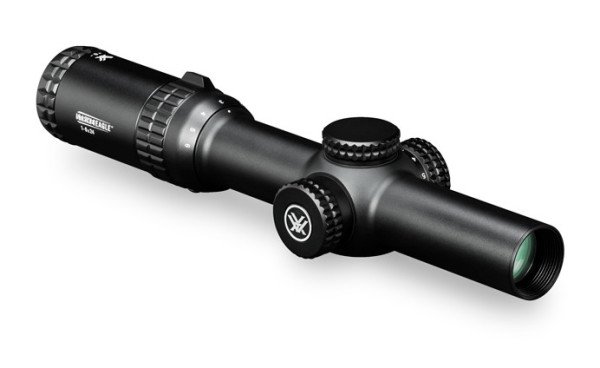
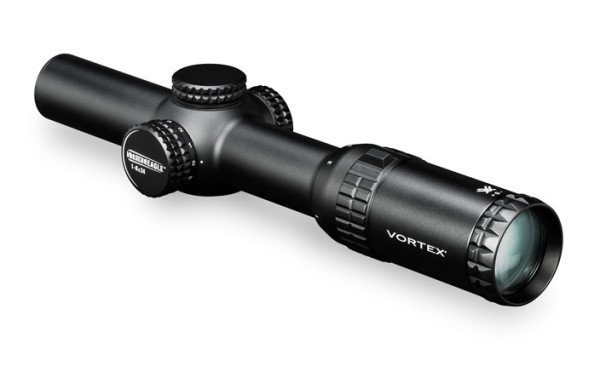
Tube & Lens Coatings
For longevity and low maintenance, the Strike Eagle’s exterior has been coated with a durable, low-glare, hard anodized finish, for good protection and concealment from glare. The Strike Eagle comes with fully multi-coated lenses for greater light transmission, while also providing anti-reflection qualities. That means a higher quality of picture to the shooter’s eye, without exposing the shooter’s position, a key feature for law enforcement work.
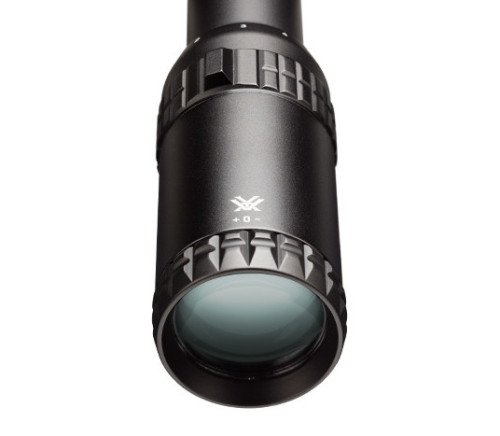
A question was asked on the Vortex website about the quality of the lenses. The rep responded that the Strike Eagle lenses are not as good as Vortex’s high-end “Viper” series of scopes, and is more in line with their “Diamondback” line of optics. However, at the price point the Strike Eagle is being offered, I still think you are getting a lot of great features to meet a variety of close-up and medium range needs.
Reticle
The Strike Eagle has a second focal plane reticle so the image zooms in while the reticle remains the same size. Many prefer this over a single focal plane reticle because the reticle doesn’t get so large that it can block some of the shooter’s view of the target. The reticle provides (11) brightness settings to meet the shooter’s needs in any lighting condition. That reticle is also glass-etched, which is a great benefit over standard reflex (red dot) optics. If the battery goes down, you may lose illumination, but you still maintain an aiming crosshairs.
The CR2032 battery is located inside of the illumination turret, making it easy to replace by simply unscrewing the end cap. Another great feature is the ability to store a back-up battery inside the windage turret. There is a space behind the end cap that will store another CR2032 battery for a quick change.
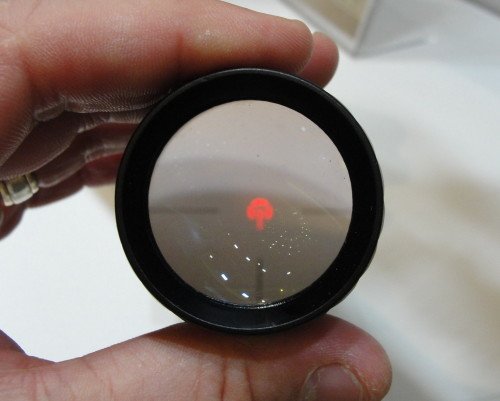
Markings within the reticle provide for an “average” bullet drop compensation (BDC) for the most popular AR-15 .223/5.56mm bullet weights. Though I can’t say for sure, I would imagine that the “average” weight considered the most popular bullets weighing of 55 or 62 grains. There are windage holdover markings as well.
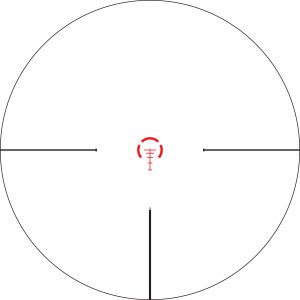
The Strike Eagle can be used with AR-15’s having an A2 front sight. The A2 sight will be slightly visible in the scope at magnifications of 1-3, and will disappear at higher magnifications.
Water, Fog, & Shock Proof
The Strike Eagle is built with O-rings at key mating points to prevent moisture, dust or debris from entering into the scopes vital components. In addition, the Strike Eagle tube has been nitrogen gas purged to prevent fogging in a wide range of temperatures. Finally, the overall construction materials and design protect the internal components from rifle recoil, bumping into objects, and falls from short distances. In fact, the Vortex reps had no problems recommending the Strike Eagle for use on a .45-70, .375 H&H, or with .458 SOCOM.
Vortex Strike Eagle Specifications
- Material – Aircraft-grade aluminum, single piece tube
- Length – 10.5″
- Weight – 17.6 oz.
- Tube Size – 30mm
- Objective Lens Diameter – 24mm
- Eye Relief – 3.5″
- Magnification – 1-6x
- Reticle – Bullet Drop Compensated (BDC)
- Illumination – 11 settings
- Battery – CR2032
- Battery life – 125-150 hours on high illumination
- Field of View (FOV) – 116.5′ @ 100 yards on 1x; 19.2′ on 6x
- Turret Style – Capped; Finger adjusted
- Turret Adjustments – 1/2 MOA per click; 44 MOA per rotation
- Max Elevation Adjustment – 280 MOA
- Max Windage Adjustment – 280 MOA
- Parallax Setting – 100 yards
- Protective end covers included
- Vortex VIP Warranty – Unlimited, lifetime, transferable
- Available – May-June, 2015
- MSRP – $429.00.
Magnified AR-15 Optics
The market has had 1-4x scopes for several years now, and they are still a very viable part of AR-15 optic selection. Some shooters have outfitted their target or hunting AR-15’s with traditional scopes with even greater magnification as well.
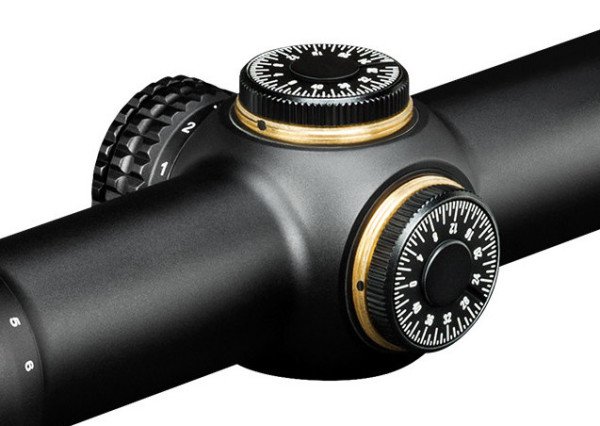
However, the new 1-6x magnification scopes, I believe, are going to overtake the 1-4x scopes and become some of the most popular optic selections for AR-15 shooters. My belief is formed on several developments in the common uses of the AR-15 platform.
Reasons the 1-6x Scopes Will Prevail
First, law enforcement agencies around the country have been faced with situations that fell squarely in the middle ground between CQB and long-rang sniper deployment. Think of the manhunt in Pennsylvania for the murderer of the State Trooper. Covering heavily wooded terrain is going to land in that middle area. A reflex sight can very likely not provide the accurate aiming point desired at greater distances, yet a sniper’s rifle has too much magnification for the terrain and not enough rapid fire capability to meet a mobile armed threat in dense terrain.
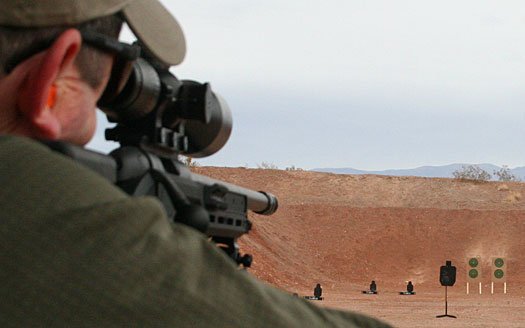
The 1-6x optic provides officers with the best of both worlds. Reflex sights are great for short-range work, but much more tedious as distance increases. The 1-4x scope added some distance through magnification, but are still somewhat limited in precision shot ranges beyond 100 yards. The 1-6x scope bridges the gap and can provide the greater magnification reach necessary to cover almost every mid-range shot. When every shot fired by a law enforcement officer must be accounted for, that extra bit of zoom to positively identify your target, threat level, and aiming point, is something that officers and Command Staff must seriously consider. At the same time, the optic can quickly be dialed down to provide a high quality reflex sight.
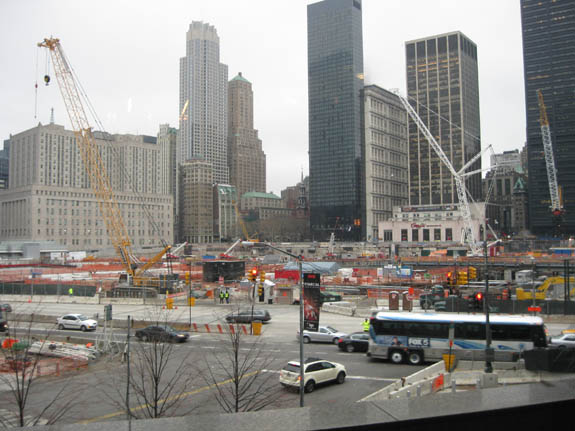
Second, the increasingly popular 3-gun and other AR-15 competition shooting matches have continued to expand the distances of targets to the point that some matches have a 300-yard target. Yet, at the same time the shooter must transition to close-in shooting within fractions of a second. Some shooters combine an optic with off-set iron sights, but that changes shooting posture. Having a constant cheek weld, shooting position, and optic view can be very beneficial to accuracy. When time and accuracy not only mean hitting the target, but can mean a big pay-off in prize money, the shooter must really consider best shooting options.
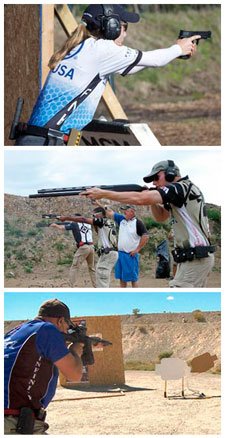
Finally, the AR-15 platform has morphed into just about an all-purpose rifle system with the addition of a wide range of calibers from .22 LR – .50 Beowulf. This has opened the rifle to a much greater opportunity for small and large game hunting. The 1-6x scope with Bullet Drop Compensator can provide an outstanding optic selection to cover many of the hunting situations that are faced in the field.
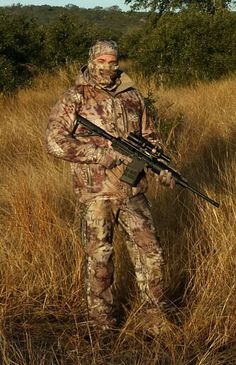
Drawback Considerations
For as good as the Vortex Strike Eagle is there are a few drawback that a shooter must consider. First, as the first picture shows, mounting the Strike Eagle will all but eliminate having a folding back-up iron sight (BUIS), which many prefer. Even if you do mount the Strike Eagle forward enough for a BUIS, the sights will not be truly focused due to the prisms and refractive lenses of magnified optics. The etched reticle does allow for an aiming point even without illumination, but this is still a consideration.
The weight of the Strike Eagle is more than many low profile reflex sights, and another factor any shooter must evaluate for pros and cons. Finally, the BDC reticle provides some great benefits in longer range shooting, but creates a larger “dot” that could hinder the speed of reflex shooting.
valery1959 says
I don’t agree. Look at http://www.alloutdoor.com/2014/09/29/review-burris-ar-15-3x-magnifier/
Friendly, Valery